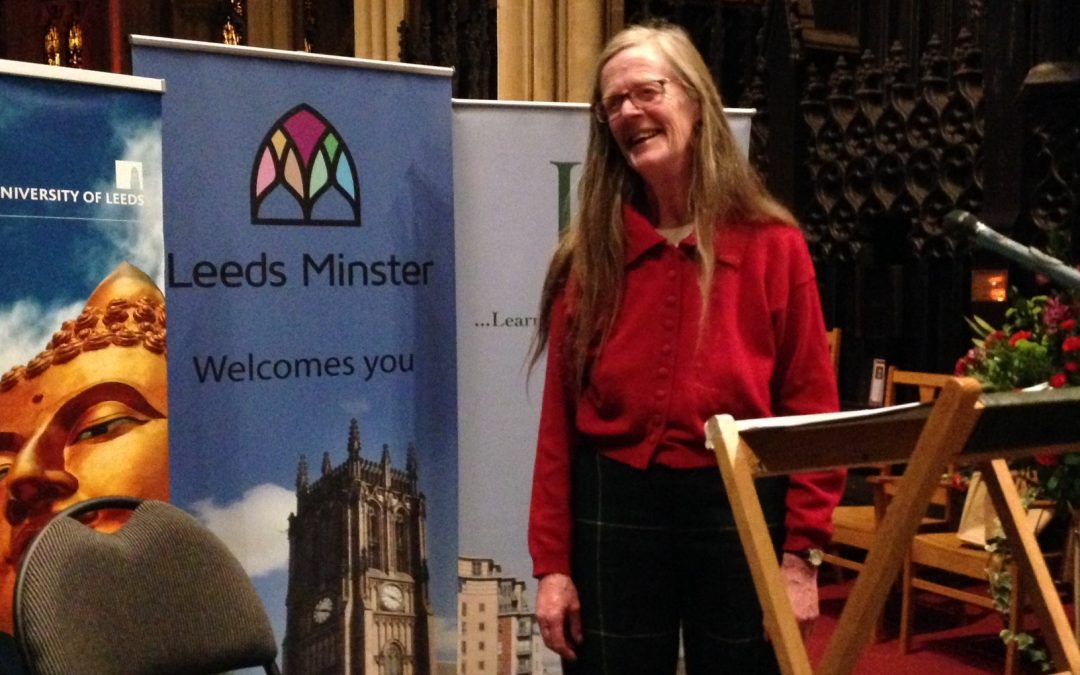 Thoughts on the 2014 Hook lecture from Sara Maitland
Thoughts on the 2014 Hook lecture from Sara Maitland
Stroma McDermott
Her theme was derived from placard slogans during the textile strikes in Lawrence. Massachusetts in 1912, eventually named ‘the bread and roses strikes’ by socialist union organizer Rose Schneiderman. Schneiderman credited the success of the strikes to women’s involvement within the Union movement, helping to create the efficient and successful organisation of multi-ethnic groups of strikers. The women argued there was;
“no harder contest than the contest for bread…but workers must have bread and roses.”
Maitland took up this idea of the need for roses, that sense of something beyond the everyday physical that humans need at the deepest level. Combining this with Aquinas’ ‘God is Beauty’, she created a simple equation that if God is beauty and God is just, then beauty can inspire us to justice.
The problem she addressed is that the idea of the beauty of God seems lost within contemporary theology and life. Instead we have distorted views of beauty, with the underlying implication that we have distorted views of God. We no longer see and experience what is around us with the fullness of our senses, especially that which is beautiful and points beyond.
As part of LCI’s monthly Wild Retreats we are observing the changing City landscape and story. A lot of what Sara Maitland suggested resonated with our discussions and observance. Encountering the natural world around us is one of those points of treasure or beauty that allows us mystical revelation of God, but so often our lives are timetabled to provide limited access and reception of what is all around us.
Sallie MacFague, the feminist eco-theologian argues the natural beauty of God’s revealed world should act as a catalyst for our theology of flourishing,
“the fate of the oppressed and the fate of the earth are inextricably interrelated… the necessary relationship of justice and ecological issues” (Sallie MacFague, Abundant Life).
Maitland’s view that beauty should inspire us to justice falls into a similar vein, despite her guarded views on wind turbines she clearly allows the natural world around her to speak of justice. The loss of beauty can predicate the loss of justice.
Yet she spent a considerable time unpacking the idea that society sees beauty as a “snare and delusion”, which distracts from the task of justice. Beauty is ephemeral and trivial, necessarily avoiding real truths and often held in opposition to them, encouraging pleasure and worldly frivolity. Beauty, she argues is paradoxical, a divine characteristic which enables our connection to the divine whilst also being a disruptive and potentially dangerous indulgence through which we could abandon our social activation and prefer our own social pleasure. Beauty fuels our selfishness, taking away our need to look to the other and ensure justice for all.
Yet beauty can be the inspiration for some of the greatest acts of love and humility. Christ’s crucifixion is an image both cruel and beautiful, horrifying yet promoting and inspiring justice. Beauty has the psychological potential to relocate us into a larger, dynamic framework. Beauty can open us to awe, to a sense of unconscious profound fear and wonder, but again Maitland noted that our sense of fear and awe is also decreasing as we diminish our experience and expectation of the divine. Fear and awe are unfashionable, not beautiful even though the prophet speaks of ‘fear as the crown of gifts that the spirit will give’ (Isaiah 11).
The award winning film American Beauty included themes of love and the aesthetic of beauty. It contrasts as Maitland does between the superficial, possessive and sugary Eros love and beauty and that of the dispossessive and selfless, flowing Agape love and beauty. In one of the iconic scenes Ricky has an epiphany as he sees a plain white plastic bag float past;
“That’s the day I realized that there was this entire life behind things, and this incredibly benevolent force that wanted me to know there was no reason to be afraid, ever… Sometimes there’s so much beauty in the world, I feel like I can’t take it, and my heart is just going to cave in.”(Ricky Fitts, American Beauty)
We might balk that such an image could provide divine revelation yet Bonheoffer suggested
“God can use all things for the fulfillment of divine purposes, however absurd the details”(D.Bonhoeffer, Letters and Papers from Prison).
Beauty is often most evident in the small, everyday details of our lives. Like Maitland, I still get excited at finding conkers.
Sarah Millar commenting in Saeculum Journal argues that by advocating transcient beauty and satirizing superficial beauty (as both American Beauty and Maitland do) we create counter-cultural thinking allowing beauty to have a liberational aesthetic. Dostoyevsky too considered beauty as salvific and Leibniz argued for an aesthetic totality theodicy where God can bring the good out of evil, something that the Q and A session after the lecture touched upon. Beauty as theological material is not new, but potentially needs rediscovering.
Yet as I have reflected on her talk I am questioning whether my experience of beauty contributes to a desire for justice. As Christmas approaches I am conscious of the many adverts and appeals for NGO’s working in West Africa with the Ebola crisis and the re-emergence of the now 30-year-old Band Aid single. The ‘bread’ is obvious; shocking images, science graphics and detailed statistics tug at the heartstrings, encouraging us to heed the crisis and do the right thing. But where are the ‘roses’? Is it the ugliness rather than the beauty that inspires or influences us? In addressing immediate physical needs (bread), do we consider what the roses might be or look like to those dying or caring for those with the disease.
Latin American liberation theologian Gustavo Gutierrez said,
“When one is concerned about one’s own stomach, it’s materialism, but when one is concerned about other people’s stomachs it is spirituality.”
Is our spirituality generous and far reaching enough to consider the roses in justice?
At our LCI Thursday ‘Conversation’ one member brought in a copy of Metro containing an article about ‘Ikeart.’ Ikea have introduced a new range re-interpreting famous grand masters with contemporary photographic tableaux. Somehow the composition lacked the beauty and awe of the original and the pictures lost a lot in translation. The bread was there but the rose had gone. Taking up Sara Maitland’s concerns, once beauty fades and dies, what are we left with and who can find it for us? This year’s hook lecture quite rightly left us with more questions than answers.

